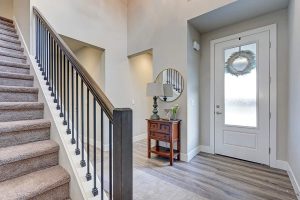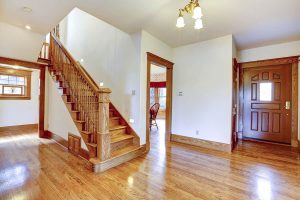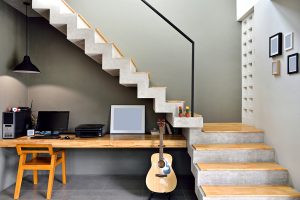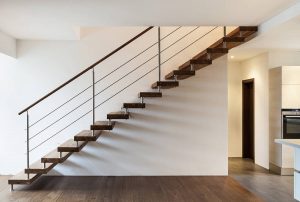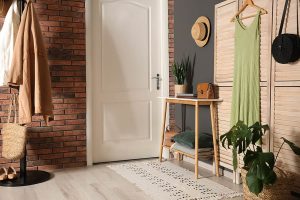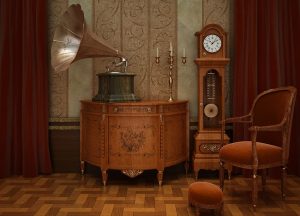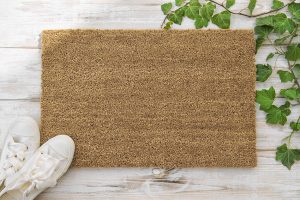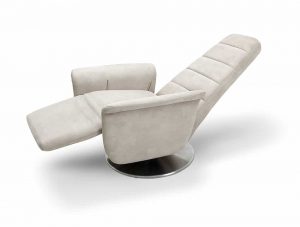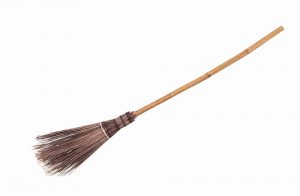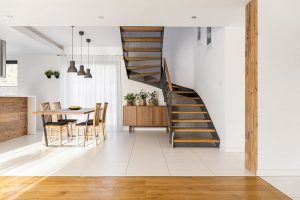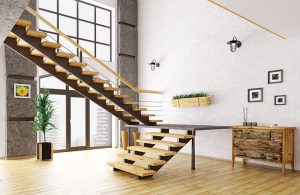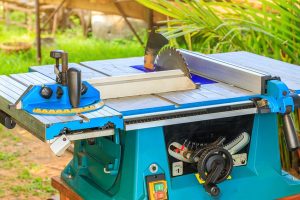A staircase provides easy and quick access to upper floors of the house, but aside from serving a functional purpose, it also increases the aesthetic appeal of the property. If you’re thinking ofconstructing a staircase, you should first get to know the different parts of a staircase and their purpose.
To learn more about the maincomponents of a staircaseand its design, take a look at my extensive guide below.
In This Article
The Definition of the Main Staircase Parts:

- Inner stringer: the hidden edge of the staircase set against a wall which locates the tread and riser.
- Outer stringer: the visible edge of a staircase which locates the tread and riser.
- Tread: the horizontal part of a step
- Riser: the vertical part of a step.
- Newel post, drop, and cap: the vertical posts at the end or turn of banisters.
- Baluster: this is a vertically moulded shaft, lathe-turned, or square, form to support the handrails.
- Railing: the handrails of a staircase that are installed along the edge of a landing and provide additional support when ascending or descending.
- Return nosing: the moulding that’s fixed to the ends of the treads and visible in a hallway. Some stairs may not have nosing.
- Fascia: the vertically covered section located below the edge of a visible landing.
- Landing: the flat area of flooring at the top and bottom of a staircase leading to downstairs or upper rooms.
- Steps: the steps of a staircase for ascending and descending. They compose of tread & riser.
Inner stringer
Theinner strings是木板——這不是線程將tread and riser. These strings act as the edging of the stairs in order to hold them together. The closed or inner string covers the face of the stairs, which means the profile of the staircase can’t be seen.
Outer stringer
The opposite of an inner string is anouter string。這是牆上的木樓梯,which is used to fasten the tread and riser. The upper edge of the outer string is cut so that the profile of the stairs can be visible from the side. The outer stringer allows you to experiment with tread nosing and brackets so that you can give your stairs a creative touch.
Treads
One of the main components of a staircase is atread。This is the flat, horizontal part for your feet to be placed on when going up or down the stairs. It’s also possible to add a carpet or other anti-slip floor coverings to the treads of the stairs in accordance with your needs. Keep in mind that the minimum depth of a tread has to be 10 inches.
Treads come in a variety of different materials, including wood, glass, tile, acrylic, or steel.
立管
立管are the second most important part of the staircase after treads. These are the vertical parts that are placed in between the treads. Some staircases, such as spiral and outdoor deck steps, don’t have risers at all as you don’t actually put your feet on the risers. But for aesthetic and safety purposes, some people prefer to have a riser.
立管can be made from wood, steel, glass, tile, or acrylic.
Railing
Thehandrailsare a practical and secure feature to prevent falling off from the open side of the stairs. The railing can be designed in many different ways. For example, it can compose metal balusters or be in plain wood. The ideal height of the railing should be between 75 and 95cm, and the grip between 3 and 6cm wide. Posts are almost always used to support handrails.
The typical materials for handrails include wood, stainless steel, wrought iron, glass panels, or aluminum.
Newel Posts
The parts of the staircase that connect the railing to the base rails are referred to as the “newel posts”。These are sturdy vertical-shaped posts at the turn or edge of a banister. The newel posts are the key structural features of a staircase and they can be customized with a wide range of materials and styles.
Newel drop
As a decorative effect, the newel posts above the landing can extend below the ceiling level. This is known as“newel drop”, which is where the open landing and newel drop can be seen. However, for even more support to the staircase and landing, some people prefer using newel story, which helps the newel post extend below the ceiling and all the way to the floor.
Newel cap
Another decorative effect for newel posts is a newel cap, which is added to the top of the post. It can consist of a plain and simple flat cap or a carved, handmade ornament, such as a figure, urn, ball, or spikes.
Balusters
Also known as spindles, thebalustersare the smaller vertical and decorative features that appear between the newel posts. Balusters provide extra support to the handrails and are located under the banister space on the side of a landing or tread. We can safely say that the overall design of the staircase isn’t complete without balusters.
Balusters are typically made from stone, wood, and even metal in a plain or decorative style.
Return Nosing
Thereturn nosingis the finishing edge of the treads that make climbing up and down the stairs more comfortable – even barefoot. Although this component is somewhat unnecessary, it generally gives a more aesthetically pleasing appearance to the staircase. But remember not to make the nosing overhang too much otherwise you may trip and fall. The ideal range is anything between 0.5 to 2cm.
典型的材料恢複的前緣be made from include vinyl, wood, and aluminum. Sometimes, stairs do not have nosing.
Fascia
The vertical floor covering at the top of the stairs is called fascia. The purpose of fascia is to act as a continuation of the outer stringer that hides the visible flooring.
Landing
Thelandingis the floor at the stairs’ top and bottom parts, which leads to the upper rooms and the lower ones. As a general rule, the landing shouldn’t have a rise of more than 3.5 meters between the floor levels. This amounts to a maximum of 20 risers.
There are several reasons for using landings between the stairs. These are:
- To increase the steepness of the staircase
- To allow corners for the staircase
- For safety purposes. Having a landing minimizes the chances of falling plus it makes the staircase structurally more sound.
There are three main types of landing used to make a turn in a staircase. These are:
- Quarter space landing: this is when the length and width of the landing are equal with the stairs’ width. The outgoing flight of stairs must allow 90 degrees turn to the upcoming flight, but it’s also possible to have two outgoing flights in the staircase in order to create a T effect.
- Half landing: when the width of the landing is the same size or twice the width of the stairs, the outgoing flight of stairs can join the upcoming flight.
- Split landing: when the landing is split by a diagonal step as it turns 90 degrees. The split landing doesn’t need to be as long as the other landings.
Steps
The steps combine a staircase’s riser & tread. vThestepsof your staircase can be in many different shapes, sizes, and materials. The style of the staircase will determine the steps you can have. But as far as the step styles go, you have three options:
- Acurving bullnoseend step at one or both ends. It’s more like a quarter circle shape. The bullnose step helps provide a wider step, although it doesn’t stretch as wide as the newel.
- Astraight step: this is the very first step that starts from the newel post instead of the ones beyond it.
- Acurtail step: if you want your staircase to stand out as a focal point, a curtail step is a great option. This is an ornately shaped step at the bottom of the stairs that’s used to support the curve at the bannister’s end. A curtail step at the end of the handrail is a beautiful decorative finish that you can enjoy looking at while going up the stairs.
There are three types of curtail steps to choose from. These are:
- Asingle curtail: when the curve stretches beyond the staircase’s width but with only a single tread, it’s known as a single curtail.
- Adouble curtail: when the curtail extends two steps back to the same level of the riser on the second step, it’s referred to as a double curtail.
- Atriple curtail: the same goes for the triple curtail, except this is where it extends three steps back to the riser. This type of curtail step is less common than the previous two.
By now you should have a better understanding of the different parts of a staircase, and the materials they can be made from. With this knowledge in mind, you will be able to plan, or even create, your dream staircase.


